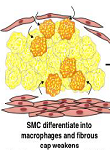|
|
|
Smooth Muscle Cell to Macrophage Differentiation in Atherosclerosis - Remaining Limitatio
|
|
|
|
|
|
|
|
|
|

|
|
|
Ashley M. Fenn
|
|
|
|
Harvard Medical School
|
Center for Systems Biology, Massachusetts General Hospital, Harvard Medical School, Boston, MA 02114, USA.
|
|
afenn@mgh.harvard.edu
|
|
|
|
|
|
|
|
|
|

|
|
Macrophages contribute decisively to the initiation and progression of atherosclerosis. Although most studies conclude that plaque macrophages derive from circulating monocytes, there is growing evidence that vascular-resident smooth muscle cells (SMCs) may also differentiate into macrophages and contribute to the growing pool of foam cells in the atherosclerotic plaque. Understanding of SMC-to-macrophage differentiation has been clouded by inadequate fate-mapping studies and potentially inaccurate staining of SMC- or macrophage-specific markers. A new study published in Nature Medicine by Shankman et al., used a novel fate-mapping technique to label SMCs early in atherosclerosis and definitively assess their cellular fate throughout the progression of disease. The authors conclude that SMCs make up a striking number of cells in the atherosclerotic plaque, but lose several SMC-specific markers masking their inclusion in previous studies. Although this research illustrates the plasticity of SMCs and the importance of SMC retention in ameliorating atherosclerosis, it, unfortunately, does not confirm that SMCs differentiate into functional macrophages nor provide proof that SMC-to-macrophage differentiation is important for the progression of atherosclerosis.
|
|
|
|
|
|
|
|

|
|